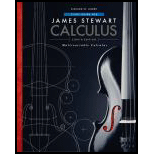
Study Guide for Stewart's Multivariable Calculus, 8th
8th Edition
ISBN: 9781305271845
Author: Stewart, James
Publisher: Brooks Cole
expand_more
expand_more
format_list_bulleted
Concept explainers
Question
Chapter 11.7, Problem 2PT
To determine
Whether the given statement, “
Expert Solution & Answer
Trending nowThis is a popular solution!

Students have asked these similar questions
If h(x)
=
-2x-8
49x2-9
what is lim h(x)?
x--00
Question
Find the following limit.
Select the correct answer below:
○ 0
○ 3
○ 6
∞
6x + 3e
lim
00+2
x 2
What is the limit as x → ∞ of t(x) =
=
√81x2
-3x+5
Chapter 11 Solutions
Study Guide for Stewart's Multivariable Calculus, 8th
Ch. 11.1 - limnn2+3n2n2+n+1= a) 0 b) 12 c) 1 d)Ch. 11.1 - Prob. 2PTCh. 11.1 - Prob. 3PTCh. 11.1 - Sometimes, Always, or Never: If {an} is increasing...Ch. 11.1 - Prob. 5PTCh. 11.1 - Prob. 6PTCh. 11.1 - Prob. 7PTCh. 11.1 - Prob. 8PTCh. 11.2 - Prob. 1PTCh. 11.2 - Prob. 2PT
Ch. 11.2 - Prob. 3PTCh. 11.2 - Prob. 4PTCh. 11.2 - Prob. 5PTCh. 11.2 - Prob. 6PTCh. 11.2 - Prob. 7PTCh. 11.2 - Prob. 8PTCh. 11.3 - For what values of p does the series n=11(n2)p...Ch. 11.3 - True or False: If f(x) is continuous and...Ch. 11.3 - Prob. 3PTCh. 11.3 - Prob. 4PTCh. 11.3 - Prob. 5PTCh. 11.3 - Prob. 6PTCh. 11.4 - Prob. 1PTCh. 11.4 - Prob. 2PTCh. 11.4 - True or False: n=1n+n3n2/3+n3/2+1 is a convergent...Ch. 11.4 - Prob. 4PTCh. 11.4 - Prob. 5PTCh. 11.5 - Prob. 1PTCh. 11.5 - Prob. 2PTCh. 11.5 - Prob. 3PTCh. 11.5 - Prob. 4PTCh. 11.6 - Prob. 1PTCh. 11.6 - Prob. 2PTCh. 11.6 - Prob. 3PTCh. 11.6 - Prob. 4PTCh. 11.6 - Prob. 5PTCh. 11.6 - Prob. 6PTCh. 11.7 - Prob. 1PTCh. 11.7 - Prob. 2PTCh. 11.7 - Prob. 3PTCh. 11.7 - Prob. 4PTCh. 11.7 - Prob. 5PTCh. 11.7 - Prob. 6PTCh. 11.8 - Sometimes, Always, or Never: The interval of...Ch. 11.8 - Prob. 2PTCh. 11.8 - Prob. 3PTCh. 11.8 - Prob. 4PTCh. 11.8 - Prob. 5PTCh. 11.9 - Prob. 1PTCh. 11.9 - For f(x)=n=0x2nn!, f(x) = a) n=1x2n1n! b)...Ch. 11.9 - Using 11x=n=0xn for |x| 1, x1x2dx= a) n=0x2n2n b)...Ch. 11.9 - Using 11x=n=0xn for |x| 1 and differentiation,...Ch. 11.9 - From 11x=n=0xn for |x| 1 and substituting 4x2 for...Ch. 11.10 - Given the Taylor Series ex=n=0xnn!, a Taylor...Ch. 11.10 - Prob. 2PTCh. 11.10 - Prob. 3PTCh. 11.10 - Prob. 4PTCh. 11.10 - Prob. 5PTCh. 11.10 - Prob. 6PTCh. 11.10 - Prob. 7PTCh. 11.10 - Prob. 8PTCh. 11.10 - Prob. 9PTCh. 11.10 - Prob. 10PTCh. 11.10 - Using a binomial series, the Maclaurin series for...Ch. 11.10 - Prob. 12PTCh. 11.11 - Prob. 1PTCh. 11.11 - Prob. 2PTCh. 11.11 - Prob. 3PT
Knowledge Booster
Learn more about
Need a deep-dive on the concept behind this application? Look no further. Learn more about this topic, calculus and related others by exploring similar questions and additional content below.Similar questions
- Consider the graphs of y = f(x) and y = g(x) in the given diagram y= f(x). y = g(x) Evaluate (f+g)(2) -5 Determine all for which g(x) < f(x) Determine all for which f(x) +3 = g(x)arrow_forwardI) For what value(s) of x does g(x) = -4? Separate multiple answers with commas as needed. J) Give the interval(s) of such that g(x) > 0. Use the union symbol between multiple intervals. K) Give the interval(s) of such that g(x) <0. Use the union symbol between multiple intervals.arrow_forwardneed help on Barrow_forward
- 4. Use the properties of limits to help decide whether each limit exists. If a limit exists, fi lim (2x²-4x+5) a) x-4 b) lim 2 x²-16 x-4x+2x-8arrow_forward7. The concentration of a drug in a patient's bloodstream h hours after it was injected is given by 0.17 h Ah= h²+2' Find and interpret lim A(h). Remember, the answers to word problems should always be given in a complete h→00 sentence, with proper units, in the context of the problem.arrow_forward#2arrow_forward
- 2. We want to find the inverse of f(x) = (x+3)² a. On the graph at right, sketch f(x). (Hint: use what you know about transformations!) (2 points) b. What domain should we choose to get only the part of f (x) that is one- to-one and non-decreasing? Give your answer in inequality notation. (2 points) - c. Now use algebra to find f¯¹ (x). (2 points) -4- 3- 2 1 -4 -3 -2 -1 0 1 -1- -2- --3- -4 -N- 2 3 4arrow_forward1. Suppose f(x) = 2 4 == x+3 and g(x) = ½-½. Find and fully simplify ƒ(g(x)). Be sure to show all x your work, write neatly so your work is easy to follow, and connect your expressions with equals signs. (4 points)arrow_forwardFind the ane sided limit lim 2 x+1-3x-3arrow_forward
Recommended textbooks for you

Sequences and Series Introduction; Author: Mario's Math Tutoring;https://www.youtube.com/watch?v=m5Yn4BdpOV0;License: Standard YouTube License, CC-BY
Introduction to sequences; Author: Dr. Trefor Bazett;https://www.youtube.com/watch?v=VG9ft4_dK24;License: Standard YouTube License, CC-BY